The taxation system of the city was based on income. Taxes were assessed on agricultural products coming from the fields into the city and all goods traded through the port, both imports and exports.
THE FOLLOWINGS ARE FROM THE "HISTORIA NUMORUM" a manual of Greek Mumismatics
http://www.snible.org/coins/hn/bithynia.html
Cius (Ghemlik), at the head of the gulf of the Propontis, which took its name from the city, was, according to Mela, the most convenient emporium for Phrygia. It was said to have been founded by Kios or by Hylas, Argonauts and companions of Herakles. On some of the coins Herakles is himself called ΚΤΙCΤΗC.
There are no early coins of this town, its first issues dating from the age of Alexander the Great. All the gold staters known come from the Sidon hoards, which appear to have been buried either about B.C. 308 (Rev. Num., 1865, 8) or about B.C. 288, if the dates upon the gold coins of Ace in these hoards are to be reckoned from the Seleucid era. Six (N. C., 1885, p. 42) dates the earliest coins of Cius, B.C. 321.
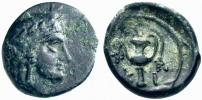
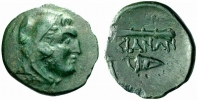
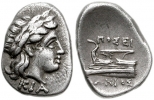
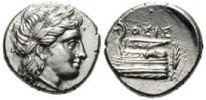
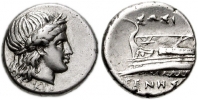
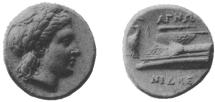
| Head of Apollo. | Prow, ornamented with star, and magis- trates name,
ΑΓΑΣΙΚΛΗΣ, ΑΓ- ΝΩΝΙΔΗΣ, ΙΕΡΟΚΛΗΣ, ΠΡΟΞΕ- ΝΟΣ.
AV Stater.
|
| Id. Beneath, ΚΙΑ. [On the weights of the AR see Imhoof in Journ. Int., 1898, p. 19.] | Id. (For magistrates names see Rec. gén., p. 311 f.).
AR Persic Drachm 81 grs.
AR ½ Drachm 40 grs. AR ĵ Drachm 20 grs. |
| Young male head, in Persian head-dress (Mithras ?). | ΚΙΑΝΩΝ Club.
Ĉ .7
|
| Id. [Cf. Hunter Cat., II. p. 242, No. 5; Journ. Int., 1898, p. 19.] | ΚΙΑ Kantharos, grapes, and ears of corn.
Ĉ .65
|
| Head of Apollo. | ΚΙΑΝΩΝ Club.
Ĉ .7
|
| Head of Herakles. | Club and bow in case.
Ĉ .8
|
| Laurel-wreath. | Club and lion-skin.
Ĉ .8
|
Under the rule of the earlier kings of Bithynia the silver coinage ceases. Philip V of Macedon destroyed the town in B.C. 202 and gave the site to Prusias I. It received from the latter the name of Prusias ad Mare, and struck bronze coins, reading ΠΡΟΥΣΙΕΩΝ ΤΩΝ ΠΡΟΣ ΘΑΛΑΣΣΗΙ: obv. Head of Herakles, rev. Club and bow in case; obv. Head of Apollo, rev. Tripod. One with name of an ΑΡΓΥΡΟΤΑΜΙΑΣ.
Between the conquest of Bithynia by the Romans, B.C. 72, and the accession of Augustus occur the coins of two queens, Musa, daughter of Orsobaris, and Orodaltis, daughter of a King Lycomedes (Reinach, Tr. Roy., p. 135); obv. ΒΑΣΙΛΙΣΣΗΣ ΜΟΥΣΗΣ ΟΡΣΟΒΑΡΙΟΣ, Head of Musa, rev. ΠΡΟΥΣΩΝ ΤΩΝ ΠΡΟΣ ΘΑΛΑΣΣΗΙ Head of Herakles. AE. Also obv. ΩΡΟΔΑΛΤΙΔΟΣ ΒΑΣΙΛΕΩΣ ΛΥΚΟΜΗΔΟΥΣ ΘΥΓΑΤΡΟΣ Head of Orodaltis, rev. ΠΡΟΥΣΙΕΩΝ ΠΡΟΣ ΘΑΛΑΣΣΗ, Fulmen. Ĉ. (Rec. gén., p. 316)
Under the Romans Cius recovered its original name, and Imperial coins are known from Claudius to Saloninus. Inscr., ΚΙΑΝΩΝ, ΑΔΡΙΑΝΩΝ ΚΙΑΝΩΝ (chiefly Hadrian), CЄΥΗΡΟΥ ΒΑCΙΛΕΥΟΝΤΟC Ο ΚΟCΜΟC ЄΥΤΥΧЄΙ ΜΑΚΑΡΙΟΙ ΚΙΑΝΟΙ (Sept. Severus). Types: